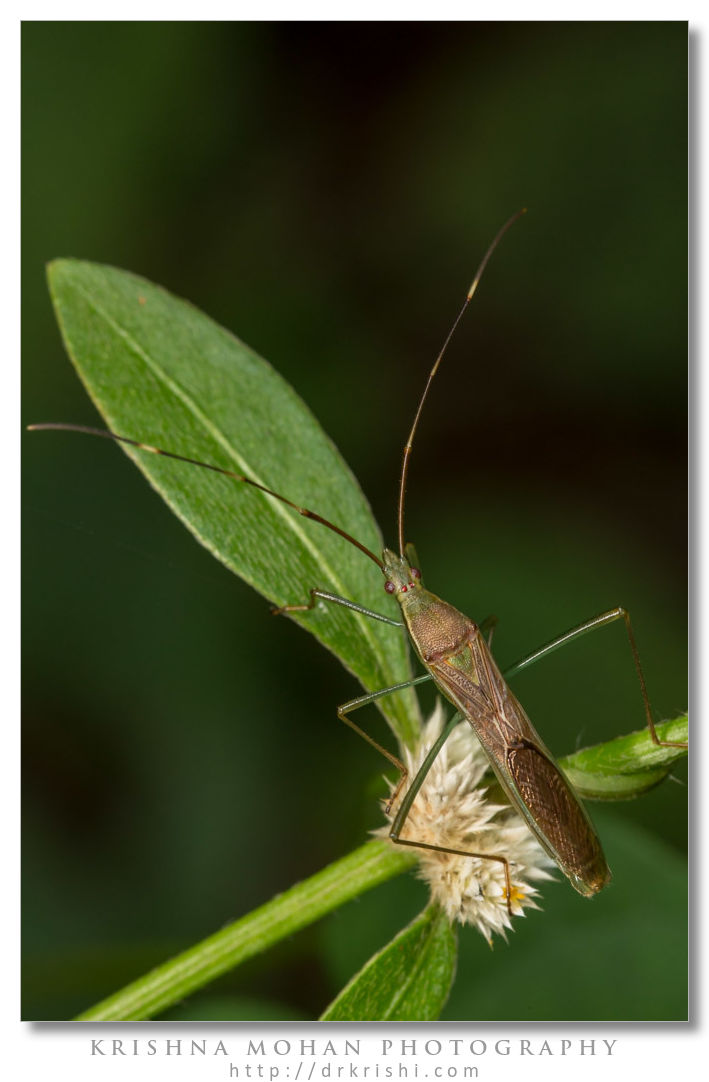
I found this Rice bug Leptocorisa acuta feeding on young shoots of grass. I was trying to capture it using Canon EOS 5D Mark III fitted with Canon EF 100mm f/2.8L Macro IS USM. For the illumination I used Canon MT-24EX macro twin light flash covered with diffusers.
The most important rice bugs in the subtropical and tropical rice areas belong to the genus Leptocorisa. Leptocorisa is distributed in the Orient-Australian region. Rice bugs concentrate on small-scale upland rice fields that they can actively search out. They are also common in rain-fed lowland rice environments. In irrigated rice, yield loss from rice bugs that feed on grains is normally minimal because their populations are diluted in vast areas of rice planted more or less at the same time. The rice bug populations in a rice field are highly variable and damage occurs only during a short period of crop growth.
Of the various species of Rice bug are responsible for damage to the paddy crop in India, Leptocorisa acuta is a serious pest in the states of Assam, Bihar, Delhi, Kerala, Madhya Pradesh, Orissa, Tamil Nadu and Uttar Pradesh. Leptocorisa oratorius occupies the same status in parts of Kerala, Madhya Pradesh, Orissa, Tamil Nadu and West Bengal.

The adult insect is long and slender, about 14-17 mm long and 3-4 mm wide. On the average it lives for 30-50 days. It is most active during early mornings and evenings when the sun is not strong. On sunny days, the insects hide at the basal parts of the plants. The females are stronger fliers than the males. The males are capable of mating shortly after emergence, but the females start mating only 7-14 days after becoming adults. L. acuta oviposit at ground level, on litter. These egg-laying habits explain their environmental preferences. Oviposition generally commences 3-4 days after mating. A single female lays an average of 200-300 eggs in batches of 10-20, usually arranged in two or three straight rows along the midrib on the upper surface of the leaf blade. The eggs are oval, slightly flattened on the top. They are creamy white when freshly laid, but become darker as they approach hatching in 5-8 days.

The freshly emerged nymphs are tiny and green, but become brownish as they grow. They blend with the foliage and are often undetected. They start feeding 3-4 hours after hatching, and undergo five nymphal instars in a total period of 25-30 days to become adults. The feeding habits of adults and nymphs are similar. A number of alternate host plants, all in the family Gramineae, have been recorded. The insects live on grasses but prefer flowering rice. Both nymphs and adults are difficult to see in the rice fields because their colour resembles that of rice plants. Infested fields, however, can often be detected, even from a distance, because they emit a typical rice bug odour produced by scent glands on the abdomen of the insect. When disturbed, adults fly and give off the typical rice bug odour.

Various cultural and mechanical control measures are being adopted to control rice bugs. Delayed, but synchronous, planting of early-maturing varieties is suggested so that all crops ripen at the same time. Weed sanitation and eradication of alternate hosts from rice fields, levees, and surrounding areas also prevent the multiplication of the bug in rice-free periods. Mechanical control measures such as smoking the field, hand-picking of adults and nymphs, and the use of sticky traps have been suggested.
All cultivated rice varieties are susceptible to grain-sucking pests. Leptocorisa spp. Resistance is observed in a group of coarse-ground, low-yielding rice called Sathi from India. In this rice, the panicle remains enclosed in the leaf sheath and offers a sort of mechanical resistance to insect sucking. However, the compatibility of this character with yielding ability and ease of threshing is uncertain. In India, varieties Mundagakutty from Tamil Nadu and Soma from Bihar also show similar resistance.

A number of natural enemies including parasites and predators are known to attack the Rice bug at various stages. Small scelionid wasps Gryon nixoni parasitize the eggs of Leptocorisa spp. The meadow grasshopper Conocephalus longipennis preys on Rice bug eggs. Several species of spiders, e.g., Neoscona, Argiope, and Tetragnatha prey on nymphs and adults. Beauveria bassiana, a fungus, attacks both nymphs and adults. The assassin bug Nabis stenoferus is a common natural enemy of Rice bug.
Insect Pests of Rice by By M. D. Pathak, Zeyaur R. Khan is a great resource where you can learn more about similar Insect pests of Rice. You can download the book freely as PDF file from International Rice Research institute.


Hello Sir, This is Dhilip Kumar. I was completed B. sc zoology with biotechnology and I wrote International Wildlife Rehabilitation Council Exam. I had worked at wildlife photography. I would like to work with you as assistant photography. could you please give me a chance please please. I studying about wildlife disease and treatment conservation. I would like to work with you. please give me a chance please please